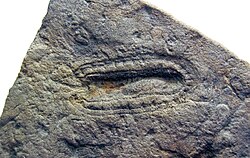| White Sea Assemblage | ||||||||||||||||||||||||||
|---|---|---|---|---|---|---|---|---|---|---|---|---|---|---|---|---|---|---|---|---|---|---|---|---|---|---|
 | ||||||||||||||||||||||||||
| Chronology | ||||||||||||||||||||||||||
| ||||||||||||||||||||||||||
The White Sea assemblage was the second of the three Late Ediacaran biotic assemblages, following the Avalon assemblage and preceding the Nama assemblage. It spanned from c. 560 Ma to c. 550 Ma. Showing an increase in genus diversity from the Avalon assemblage, it concluded with a faunal turnover often characterized as the first pulse of the end-Ediacaran extinction, with only 20% of White Sea taxa found in the later Nama assemblage despite similar taphonomic processes. [3] [4]
References
- ^ Shen, Bing; Dong, Lin; Xiao, Shuhai; Kowalewski, Michal (4 January 2008). "The Avalon explosion: evolution of Ediacara morphospace". Science. 319 (5859): 81–84. Bibcode: 2008Sci...319...81S. doi: 10.1126/science.1150279. ISSN 1095-9203. PMID 18174439.
- ^ Shi, Wei; Li, Chao; Luo, Genming; Huang, Junhua; Algeo, Thomas J.; Jin, Chengsheng; Zhang, Zihu; Cheng, Meng (24 January 2018). "Sulfur isotope evidence for transient marine-shelf oxidation during the Ediacaran Shuram Excursion". Geology. 46 (3): 267–270. doi: 10.1130/G39663.1.
- ^ Evans, Scott D.; Tu, Chenyi; Rizzo, Adriana; Surprenant, Rachel L.; Boan, Phillip C.; McCandless, Heather; Marshall, Nathan; Xiao, Shuhai; Droser, Mary L. (15 November 2022). "Environmental drivers of the first major animal extinction across the Ediacaran White Sea-Nama transition". Proceedings of the National Academy of Sciences. 119 (46): e2207475119. Bibcode: 2022PNAS..11907475E. doi: 10.1073/pnas.2207475119. ISSN 0027-8424. PMC 9674242. PMID 36343248.
- ^ Bottjer, David J.; Clapham, Matthew E. (2006). Xiao, Shuhai; Kaufman, Alan J. (eds.). Evolutionary Paleoecology of Ediacaran Benthic Marine Animals. Dordrecht: Springer Netherlands. pp. 91–114. doi: 10.1007/1-4020-5202-2_4. ISBN 978-1-4020-5202-6.